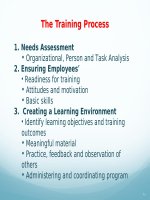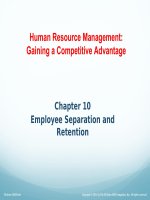Human resource management gaining a competitive advantage 2014 chapter 3
Bạn đang xem bản rút gọn của tài liệu. Xem và tải ngay bản đầy đủ của tài liệu tại đây (625.96 KB, 29 trang )
Human Resource Management:
Gaining a Competitive Advantage
Chapter 03
The Legal Environment:
Equal Employment Opportunity
and Safety
McGraw-Hill/Irwin
Copyright © 2013 by The McGraw-Hill Companies, Inc. All rights reserved.
Learning Objectives
Identify the three branches of government and the role
each plays in influencing HRM legal environment.
List major federal laws that require equal employment
opportunity (EEO) and the protections provided by
each of these laws.
Discuss the roles, responsibilities, and requirements of
the federal agencies responsible for EEO laws.
Identify four theories of discrimination under Title VII of
the Civil Rights Act and apply these theories to
different discrimination situations.
3-2
Learning Objectives, cont.
Discuss the legal issues involved with
preferential treatment programs.
Identify behavior that constitutes sexual
harassment and list things than an
organization can do to eliminate or minimize
it.
Identify the major provisions of the
Occupational Safety and Health Act
(OSHA) (1970) and the rights of employees
guaranteed by this act.
3-3
U.S. Legal System
Legislative
Branch
Judicial
Branch
Executive
Branch
3
Branches
3-4
Equal Employment Opportunity (EEO)
EEO– the government's attempt to ensure that
all individuals have an equal chance for
employment, regardless of race, color, religion,
sex or national origin.
Constitutional Amendments:
13th Amendment - abolished slavery
14th Amendment – provides equal protection
for all citizens and requires due process in
state action.
3-5
Congressional Legislation
Civil Rights Acts (1866 and 1871)
Equal Pay Act of 1963
Title VII of the Civil Rights Act of 1964
Age Discrimination in Employment Act of
1967
Rehabilitation Act of 1973
3-6
Congressional Legislation
Vietnam Era Veteran’s Readjustment Act of
1974
Pregnancy Discrimination Act
Civil Rights Act of 1991
Americans with Disabilities Act of 1990
3-7
Disability
According to EEOC, a disability is a physical
or mental impairment that
“substantially limits one or more major life
activity;
a record or past history of such an impairment;
and/or being ‘regarded as’ having a disability
by an employer whether you have one or not,
usually in terms or hiring, firing or demotion
3-8
Executive Orders
Executive Order 11246 Prohibits government
contactors from discrimination
Executive Order 11478 government employment
policies based on merit
and fitness
3-9
Enforcement of EEO
Two agencies responsible for the enforcement of
these laws and executive orders:
3-10
Equal Employment Opportunity
Commission
3 major responsibilities of EEOC:
1. Investigate and resolve discrimination
complaints
2. Gather information
3. Issue guidelines
Lilly Ledbetter Fair Pay Act
3-11
Office of Federal Contract
Compliance Programs (OFCCP)
3 components:
1. Utilization analysis
2. Goals and timetables
3. Action steps
The OFCCP annually audits government
contractors.
3-12
Disparate
Impact
Disparate
Treatment
Reasonable
Accommodation
3-13
Disparate Treatment
Disparate treatment exists when individuals in
similar situations are treated differently based
upon race, color, religion, sex, national origin,
age, or disability status.
Bona fide occupational qualifications (BFOQ)
UAW v. Johnson Controls, Inc.
McDonnell Douglas Corp. v. Green
3-14
Bona Fide Occupational Qualification
(BFOQ)
BFOQ is a a job qualification based on race, sex,
religion, etc. that an employer asserts is a
necessary qualification for the job.
3-15
Disparate Impact
Disparate impact occurs when a neutral
employment practice disproportionately excludes
a protected group from employment opportunities.
• Four-fifths rule
• Standard deviation rule
Wards Cove Packing Co. v. Antonio
Griggs v. Duke Power
3-16
Reasonable Accommodation
Reasonable Accommodation - places a
special obligation on an employer to affirmatively
accommodate an individual’s disability or
religion.
Religion and Accommodation
Disability and Accommodation
3-17
Retaliation
for Participation and Opposition
Title VII states that employers cannot retaliate
against employees for either "opposing" a
perceived illegal employment practice or
"participating in a proceeding” related to an
alleged illegal employment practice.
Employees do not have an unlimited right to talk
about how racist or sexist their employers are.
3-18
Diversity and EEO ISSUES
Sexual Harassment
Affirmative Action
and
Reverse Discrimination
Outcomes of Americans
with Disabilities Act
3-19
Sexual Harassment
Sexual harassment -unwelcome sexual advances, requests for
sexual favors, and other verbal or physical contact of a sexual
nature constitute sexual harassment when
1. Submission to such conduct is made either explicitly or implicitly
a term or condition of an individual’s employment,
2. Submission to or rejection of such conduct by an individual is
used as the basis of employment decisions affecting such
individual, or
3. Such conduct has the purpose or effect of unreasonably
interfering with an individual’s work performance or creating an
intimidating, hostile, or offensive working environment.
3-20
Sexual Harassment
Quid Pro Quo harassment
Bundy v. Jackson
Hostile Working Environment
3-21
Sexual Harassment
3 critical conditions for Sexual Harassment
cases:
1. The plaintiff cannot have "invited or incited" the
advances
2. Harassment must have been severe
3. The court must determine the liability of the
organization for actions of its employees
Preventative steps include development of a
policy statement, training, a reporting
mechanism and disciplinary policy.
3-22
Affirmative Action and
Reverse Discrimination
Affirmative Action was conceived of as a
way of taking extra effort to attract and retain
minority employees.
Imposed quota programs.
The entire debate over affirmative action
continues to evoke attention.
3-23
Americans with Disabilities Act (ADA)
Outcomes
Under ADA, a firm must make "reasonable
accommodation" to a physically or mentally disabled
individual unless doing so would impose "undue
hardship.”
Consequences of ADA:
Increased litigation
Cases being filed do not reflect Congressional intent
Act was passed to protect people with major disabilities
The law has not resulted in a major increase in the
proportion of people with disabilities who are working.
3-24
Employee Safety
Employee safety is regulated by both
federal and state governments.
The Occupational Safety and Health
Act (OSHA)
General Duty Clause
3-25









